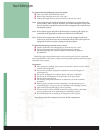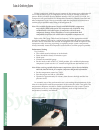
General Preparations
Always conduct a visual inspection of the air conditioning system to identify
any damage, excessive wear, refrigerant leaks (oil residue), improper belt adjust-
ment, improper pulley alignment, and plugged condenser cooling fins.
Note: Never use water to clean the condenser or radiator fins. Using compressed
air is the approved method.
Observe the refrigerant flow through the receiver/dryer sight glass (if
equipped), use the correct gauges to check all systems, verify all system compo-
nents and controls are operable, check for loose fittings, replace defective, worn, or
damaged drive belts, and repair system leaks.
Note: The use of the sight glass alone to determine system charge level can be
misleading. Normally operating and correctly charged variable displacement
compressors and R-134a systems will have bubbles showing in the sight
glass under certain conditions.
Discharging
Caution: Refrigerant R-12 has been identified as a compound which causes
damage to the ozone layer. It is unlawful to discharge R-12 into the atmosphere.
Subaru of America encourages you to handle R-12 in a responsible and safe
manner, and according to Federal EPA guidelines and any local and state regulations.
Always follow approved recovery/recycling procedures and utilize approved
recovery/recycling equipment.
Discharging and recovery of the system refrigerant is required before replacement
of major components of the system. It is also required when the system has a leak,
or for the replacement of refrigerant oil. Discharging and recovery of the system
refrigerant is the first step in preparing for major servicing, repair,
or replacement of components; the second step is evacuation.
Evacuating
Evacuating the system removes air and moisture from the system.
Discharge and recover the system refrigerant first; then follow the
steps listed below to evacuate the system:
• Fully close both valves of the manifold gauge set.
• Connect a vacuum pump to the center charging hose of
the manifold gauge set.
• Start the vacuum pump.
• Open the low- and high pressure valves slowly.
• When the pressure reading has reached approximately 29.00
in Hg, fully close both valves.
• Stop the vacuum pump.
• Wait 10 minutes, the pressure reading should not change.
If it changes, there is a leak in the system.
Note: Certain types of system leaks such as loose fittings may not
be discovered using this method. Always recheck the system
with a leak detector after the system is charged.
Elevation Vacuum of System
m (ft) mm Hg, in Hg
0 (0) 710 27.95
300 (1,000) 685 26.97
600 (2,000) 660 25.98
900 (3,000) 635 25.00
Note: Values show readings of the low-pressure gauge.
Evacuating The System
Elevation/Pressure Relationship
9











